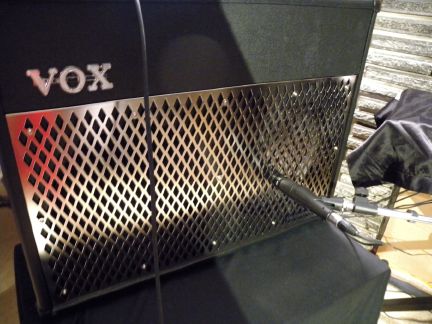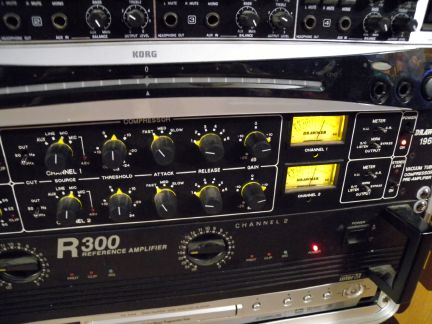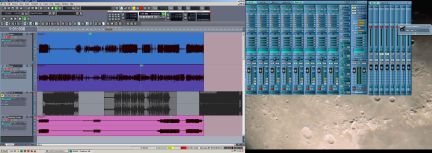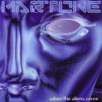Welcome readers and welcome back to another installment of Zone Recording. First off, I wanted to say thanks for reading! I have been doing these columns for years now and have enjoyed sharing my info, recording techniques and overall, what I have been up to.
I recently was asked by Vox Amplification to do two videos for the VT100 guitar amp, and the Tonelab ST guitar processor (see the video links at the end of the article).
My artist rep Evan asked me to do them in my own quirky way, making it fun, entertaining and to make sure it had great sound quality!
Upon thinking of how to do this, I knew that using the audio from the video camera would not cut it at all.
I had to figure out how to do this, and this is what I came up with.
We set up in Brainworks for the session. David Spidel, the bass player in Martone was my camera man and did a great job!
I needed to capture all the audio as the video was being shot and we would sync it up later in Final Cut (a video editing program).
I first needed to have a lav mike for me to speak into to capture great audio on the voice. I used a Wireless Shure Lav system.

This was fed into a channel on my Presonus Digimax and then sent and captured in Sonar.
Next was miking up the VT100.

I used a SM57 close miked close to the center of the speaker. This was being fed into a channel on the Drawmer 1960.

By capturing the audio this way, I was able to get a great recording sound on both the guitar amp and voice that I could process dynamically as well as automate. I will describe that a little later.
I also was playing along to tracks in some of the examples. I needed to play backing tracks in real time from my Mac, and have them recorded in real time as well as the video was being recorded.
I took a 1/8" output from the Mac and fed it into two 1/4" DI channels which then went into two channels of the Presonus Digimax via XLR.

So for the VT100 video I had 4 channles of audio being recorded simutaniously as the video was being shot.
2 channels of backing track
1 lav
1 guitar amp
For the next video I had to capture the tones of the Tonelab ST. This is a processor pedal and I chose to record the direct out of the unit. It is stereo and decided to run the TRS 1/4" output into two more DI's that then fed the Drawmer 1960.
Of course I had the lav still going so there was five channels of audio being recorded down as we shot the next video.
2 channels of backing track
1 lav
2 channels from the Tonelab ST
Everything worked quite flawless. Dave captured the video and I captured the audio.
After all the audio was captured, I worked on the audio files. First off was automating the lav channel with volume automation. I needed to bring down my lav every time I played since it was picking up the playback of the backing tracks and whatever was going on in the room as well, which was the indirect sound of the amp as well. I thought of having it in as a subtle room sound, but decided to attenuate it approx 15db. I also compressed the voice quite heavily with different layers of compression as well as a roll off at 140 Hz. Since my head was moving a lot as I was rocking out explaining things, this kept things under control.
I then did some subtle EQ and dynamics on the guitar channel. I did add a very small subtle room rev to the mono guitar and voice channel to give it a little "air".

That can be viewed here!
I then mixed this session down as a solid take from top to bottom for the VT100.
I then did the same process for the Tonelab ST. I did not add the subtle room reverb to these guitar channels since they were stereo.
Once I had both of these files mixed, I mastered them and now had two final files to give to Dave Spidel.
I did have to listen and go through the files first to give him production direction. Inside each of the files there were two takes, or attempts, at explaining each sound, function of the amp, or performance with a backing track.
I would then document this, so I could tell Dave what he had to do.
Here are the actual production notes I gave to Spidel for the Tonelab ST.
VOX TONELAB ST MUSIC CHOICES
TAKE 1
ENTRANCE
| Improv | YES | (use introduction of front face) |
| Swelling | YES | (use text explanation) |
| Piano | ||
| Angel | YES | (use text explanation) |
| Angel Fish | ||
| Moron Face | YES | (text including the youtube comment) |
| Dinky Pinky |
TAKE 2
| Improv | (use introduction of back of unit) | |
| Swelling | ||
| Piano | YES | (use text explanation) |
| Angel | ||
| Angel Fish | YES | (use text explanation) |
| Moron Face | ||
| Dinky Pinky | YES | (use summation explanation with email) |
| (use the 2nd wah improv with the facecomment) |
I broke it down into music and text explanation to make it easy on what choices to make.
Dave then imported the mastered audio files into his system and lined them up with the audio channel from the video channel. It is quite easy to do, since you import both files and just line them up visually. Since it is digital, it works out perfectly! Amazing!
After this Spidel exported the files as DV files for us to look at. We both realized that... the files were toooooooooooooo looooooooonnnnnnnnnnnggggg!
They were supposed to come in anywhere from 2-7 minutes. We were at like 12 minutes!
I guess I had too much to play and say, so now the hard part was to edit it down to under 10 minutes! Youtube has a 10 minute video restriction so it must be under.
So back and forth we went to try and edit this down! That was fun... it's always hard to cut things out, but the chopping had to happen!
May the tone be with you.
David Martone is a guitarist from Vancouver, Canada who has released seven solo CDs which showcase his musical diversity and brilliant guitarmanship.
His 2007 CD is entitled "When The Aliens Come", which features a progressive sound incorporating jazz, rock, fusion and metal influences.
